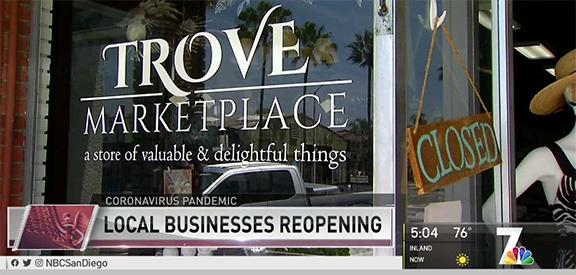We know the world, we know print, we know marketing.
Sales strategies haven’t changed much in the past 15 years, though they have evolved. Technology makes it easier to reach people and provide effective presentations for your products and services. The business world changes all the time. The current Covid-19 pandemic has changed all the rules and you could be scrambling to figure out what’s next. By adapting some traditional sales techniques, your business may well be able to survive and grow.
3 Key Sales Strategies to Land and Keep Small-Business Accounts
Sales strategies haven’t changed much in the past 15 years, though they have evolved. Technology makes it easier to reach people and provide effective presentations for your products and services.
The business world changes all the time. The current Covid-19 pandemic has changed all the rules and you could be scrambling to figure out what’s next. By adapting some traditional sales techniques, your business may well be able to survive and grow.
Key Sales Strategies 1 – KNOW YOUR BUSINESS
Be a resource
Knowing your business is an obvious place to start. But it’s so basic that it practically disappears as a salesperson’s tool for success. This sales strategy is two-pronged:
What products and services does your business offer?
- Know the details, the variations, the discount points.
- You won’t be merely an order taker, but a matchmaker to meet your customer’s needs.
What products and services does your business not offer?
- This is the flip side of what you offer, and equally important.
- Know what businesses provide what you can’t, even if that business is a competitor.
![]() Combine deep knowledge of your products and services with a willingness to point to another source, and you become a trusted resource for your prospects and clients. see blog post LINK ECONOMY
Combine deep knowledge of your products and services with a willingness to point to another source, and you become a trusted resource for your prospects and clients. see blog post LINK ECONOMY
State your terms
When you’re ready to talk with the prospect or client about your terms for doing business, you have a chance to manage the client’s expectations. This is a traditional technique, and an important one, that applies to many of these strategies.
- What are the delivery times and options?
- How do you expect to be paid?
- When do you expect to be paid?
![]() Be both firm and fair. Building trust at this level helps find the balance between your needs and those of your client.
Be both firm and fair. Building trust at this level helps find the balance between your needs and those of your client.
Look ahead
Knowing the client’s business helps you know what they need. Understanding their budget plans for the upcoming month, season, year helps you look ahead to when they need your products and services.
- What is the value of your products or services to the prospect or client?
- Not only cost, but quality, time and reliability.
![]() Knowing what they provide and their customers’ profiles tells you which of your products and services will be most important to them.
Knowing what they provide and their customers’ profiles tells you which of your products and services will be most important to them.
Key Sales Strategies 2 – KNOW YOUR CLIENTS’ BUSINESS
Do your homework
You don’t need to learn everything your client or prospect knows about their business. But it’s crucial to invest some research time to see a few basic elements.
- What is the customer sector they serve?
- Which businesses are their competition?
- How do the key products or services they offer differ from those of their competitors?
![]() Now you have a map of their business landscape. And it guides you to offer your client ways to improve and compete more effectively.
Now you have a map of their business landscape. And it guides you to offer your client ways to improve and compete more effectively.
Walk the walk
A crucial component in small-business sales is to know where to find your prospects.
- Use an online map to plan, then spend time every day or every week to walk through industrial parks and retail streets.
- What businesses do you see that could use your products or services?
- Do they have regular hours? Are they open to the public or are they a by-appointment location?
- Is their contact information on the door or window? If yes, make a note of it for follow-up visits.
- Keep a log, spreadsheet or contact management database to track your data.
![]() Office complexes that cater to multiple tenants and co-op workspaces may be filled with sales prospects. Find them by physically going into their territory.
Office complexes that cater to multiple tenants and co-op workspaces may be filled with sales prospects. Find them by physically going into their territory.
Be businesslike
Dialogue opportunities lead to the kind of discovery that indicates if there is a chance for business. Start off with questions like these:
- How did they start the business?
- Is it family owned? A new enterprise? A second career?
- What are the goals for their business? Managed growth? Stay small and local? Positioning for an acquisition?
![]() Conversation leads to conversions.
Conversation leads to conversions.
Be curious
Business is business, right? But remember that it’s also personal. Start this dialogue by working these types of questions into your conversation:
- What is your client’s or prospect’s name?
- Where are they from originally? Did they grow up here?
- How long have they been in this location? If they moved their company from somewhere else, what prompted the move?
- Do you have experiences or colleagues in common?
![]() For all the business knowledge a sales rep has to know, it comes down to being a people-person. Get to know them, not only by the role they fill in the business, but by name.
For all the business knowledge a sales rep has to know, it comes down to being a people-person. Get to know them, not only by the role they fill in the business, but by name.
Key Sales Strategies 3 – KNOW HOW TO STAY IN TOUCH
Talk the talk
Continue with the personal approach by creating word-of-mouth referrals.
- Support youth sports by sponsoring a team.
- Advertise in newsletters for continuing learning programs or hobby clubs.
- Attend neighborhood after-school programs if you have children – parents may become customers.
![]() These casual-talk opportunities are a powerful and effective means of marketing your products and services.
These casual-talk opportunities are a powerful and effective means of marketing your products and services.
Network
Another way to network is participation in activities specifically for business people in your community. Join the organization and access their resources: workshops, trade shows, and meet-ups with business colleagues in your local territory can create and maintain business-to-business relationships.
- Business Network International (BNI)
- Chamber of Commerce (including, if active, Minority Chamber of Commerce)
- Industry and Trade Associations
- National Federation of Independent Businesses
- Rotary Club
- SCORE (Service Corps of Retired Executives)
- Small Business Association Community Groups (including one for veterans)
- Toastmasters International
- Women’s Business Development Center
![]() Time-consuming or boring, you say? Think again. Try some of these and go to several meetings. Please take your business cards and a brochure to showcase what your business offers.
Time-consuming or boring, you say? Think again. Try some of these and go to several meetings. Please take your business cards and a brochure to showcase what your business offers.
Stay in touch
Once you make contact, it’s crucial to stay in touch. Be sure to be a welcome contributor, not someone who talks endlessly about their own business.
- Visiting the client in person is powerful.
- Find a balance in the different dynamic between dropping in and interrupting their work versus calling for an appointment.
- Block time in your schedule for exploring territory and visiting prospective clients – it could be 1 or 2 hours a day, or it could be a half day, twice a week. Stick to your schedule.
- Keep in mind the changing rules of reduced hours, social distancing, face masks, and elbow bumps instead of handshakes.
![]() After the first impression, following up is the most important thing you can do. Your prospective client’s time is as valuable as your own.
After the first impression, following up is the most important thing you can do. Your prospective client’s time is as valuable as your own.
Be their customer
- When you are able, use their services and buy their products. It’s a smart move that supports your community.
- Be their customer or client and you can be even a greater asset to their business from that experience.
![]() Do we really have to explain this? Think of the old saying, "What goes around, comes around." Regard others as you would have them regard you.
Do we really have to explain this? Think of the old saying, "What goes around, comes around." Regard others as you would have them regard you.
ONE MORE THING
Next week I’ll post 3 Long-Term Sales Strategies for Small-Business Accounts. Need a reminder?

